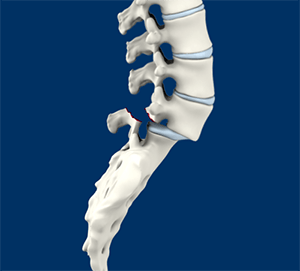
What is Isthmic Spondylolisthesis?
Isthmic spondylolisthesis is a spinal disorder in which one vertebra glides forward over the vertebra below. It usually affects the lumbar (lower back) spine, more frequently at L5-S1 levels (the fifth lumbar vertebra and first sacral vertebra). This condition is caused by a defect (which may be congenital) or a fracture (caused by excessive spinal stress) of the pars inter-articularis; a bone that joins the upper and lower facet joints in the back of the spine. This is common among athletes of young age.
Symptoms of Isthmic Spondylolisthesis
An interesting feature of this condition is that not all patients experience pain. The symptoms of isthmic spondylolisthesis include:
- Lower back pain
- Sciatica
- Leg weakness due to nerve root pinching
- Muscle contractions
- Stiffness of hamstring muscles (muscles in the back of the thigh)
- Asymmetric abnormality of gait
Causes of Isthmic Spondylolisthesis
Isthmic spondylolisthesis results from the improper formation of bone. Excessive stress rendered on the spine causes weakening or fracture of insufficiently developed vertebral structures. Repetitive activities such as heavy weight lifting, crouching, or twisting may cause fractures to occur and lead to a vertebral slip. Weightlifters, football players and gymnasts are more prone to suffer from this condition due to the significant amount of stress exerted on their spines.
Diagnosis of Isthmic Spondylolisthesis
Diagnosis of spondylolisthesis is based on the following:
- Medical history: Your doctor will ask you questions regarding your symptoms, their severity and duration; and the kind of treatment undergone for the relief of these problems.
- General physical examination: Your physician will examine you to evaluate pain, gait problems, any loss of reflexes, muscle weakness, loss of sensation or other signs of neurological impairment.
- Radiological investigations include a lumbar spine X-ray to rule out other diseases. Occasionally, a CT scan or MRI may be ordered to obtain the bone and soft tissue structures in greater detail.
Classification of Spondylolisthesis
The spinal condition can be graded according to the degree of sliding, varying from mild to severe.
The healthcare professionals use the Meyerding Grading System for the classification of vertebral body slips. This system is not difficult to understand. Vertebral slips are graded on the basis of the percentage that one vertebra has slipped forward over the one below.
- Grade I: 1-24%
- Grade II: 25-49%
- Grade III: 50-74%
- Grade IV: 75%-99% slip
- Grade V: 100%, complete slip, known as Spondyloptosis.
Treatment for Isthmic Spondylolisthesis
The appropriate treatment of these conditions depends on several aspects such as the degree of slip, pain, and neurological symptoms. Generally, grade III and above require surgery, however, grades I and II are treated conservatively.
Non-surgical treatment for most of the cases includes:
- Adequate rest for a short time
- Limitation of activities that aggravate the symptoms
- Pain-relieving medications
- Anti-inflammatory tablets
- Muscle relaxants
- Epidural steroid injections
- Lumbar braces
- Physical therapy
The spinal conditions may gradually deteriorate and cause serious problems. Hence, it is very essential that you maintain regular follow-up appointments with your spine doctor.
Surgical Treatment
Surgery is recommended if the symptoms fail to respond to conservative treatment. Severe cases of spondylolisthesis deteriorate and cause serious problems. Spinal fusions (use of bone grafts) with instrumentation (use of implants such as plates, screws, rods, interbody cages, wires, hooks) are some of the common procedures performed to halt the progression and stabilize the spine. The new advanced generation uses minimally invasive techniques; a smaller incision is made rather than the traditional large open incision. Your surgeon will discuss with you regarding the procedure in detail, the advantages, risks and complications.











